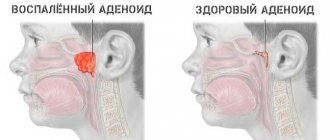Pediatric otorhinolaryngology is based on age and is quite diverse. At an early age, diseases occur that are not typical for adults, and vice versa. But there are pathological disorders that are characteristic of different age groups - these are acute conditions. The article will discuss only some of them, namely those that parents often encounter. The purpose of the article is to provide assistance at the pre-medical stage.
Bleeding from the nose in a child or epistaxis is the leakage of blood from the vascular structures of the mucous membrane. In 4% of cases, the quality of life deteriorates. More than half of the population experiences at least one episode of epistaxis. In 20% of children, nosebleeds (NB) of a recurrent type are recorded, and there are signs of chronic blood loss.
Types of nosebleeds
Nosebleeds develop due to abnormal structure of the capillary walls or due to a deficiency of blood clotting factors. There are one-time, recurrent and habitual (occur several times a year) epistaxis.
The most important classification is the division by source localization area, when viewed from a practical point of view:
- vessels of the cavity type (anterior or posterior region of the nose);
- extracavitary vessels (intracranial structures, nasopharynx, paranasal sinuses).
Anterior type nosebleeds do not pose any health hazard. Posterior NK is more intense, because in this case there is a violation of large vessels. This condition involves significant blood loss and can pose serious risks. The blood flows down the throat, penetrating the stomach and oral cavity, rather than flowing out of the nasal passages.
What types of bleeding are there?
Note that blood can come from the nose in drops, or maybe in a continuous stream. It is this sign that indicates the location of the vessels and the degree of danger. The vessels involved in blood loss can be located both in the anterior and posterior regions of the nasal cavity. In this regard, nosebleeds are divided into two types:
- Front. It occurs due to a violation of the integrity of small blood vessels located in the nasal septum and does not pose a serious danger to the child’s health. It is quite possible to stop it on your own.
- Rear. It assumes the most intense blood loss, which is caused by disruption of large vessels in the posterior parts of the nose, and this is why it is dangerous. The blood does not flow out of the nose, but flows down the throat. In this case, pinching your nose is useless; medical help is required.
Massive blood loss can be indicated by general weakness and pallor of the skin, low blood pressure and disorientation.
Thus, with severe bleeding, damage to large vessels can be assumed. Such bleeding cannot be stopped on its own; urgent medical attention is required.
Causes
As a rule, nosebleeds occur due to two mechanisms: coagulation disorders and increased permeability of vascular structures. Our nose is equipped with many small blood vessels. In the area of the anterior nasal septum they form a dense braid. Because the thin blood vessels adhere tightly to the surface of the thin septum, they can be damaged relatively easily, causing the typical nosebleed. Other blood vessels, on the contrary, are very rarely damaged.
The main causes of nosebleeds in a baby:
1. Infectious diseases (diphtheria, ARI or tuberculosis).
2. Thinning of the mucosa (atrophic form of rhinitis, long-term therapy with vasoconstrictor drops/sprays).
3. Pathologies of vascular structures and blood (hemorrhagic vasculitis, thrombocytopenia or hemophilia).
4. Symptomatic increase in blood pressure (emotional stress, excessive physical activity, heat or sunstroke).
5. Somatic diseases (lack of vitamin C, K and calcium, chronic liver diseases, vegetative-vascular dystonia, etc.).
6. Nose injuries (fracture, bruise, damage by any object, etc.).
Often a child’s nose bleeds due to disturbances in the microclimate in the room. Insufficient air humidity or high ambient temperatures lead to dryness of the mucous membrane. This helps reduce the elasticity of the vascular wall, which becomes fragile. Often a child's nose may bleed for no reason.
Preventing nosebleeds
Preventive measures aimed at reducing the likelihood of external causes of the problem, as well as some internal ones, help reduce the risk of developing recurring nosebleeds. The main recommendations for preventing the problem are as follows:
- use of humidifiers if the air is excessively dry;
- use of antipyretic drugs when the temperature rises to more than 38o;
- timely removal of benign tumors of the nasal cavity;
- quitting smoking, as nicotine smoke contributes to the development of mucosal atrophy;
- refusal of alcohol, especially strong alcohol - it leads to a sharp dilation of blood vessels, which can lead to their rupture;
- explaining to children from early childhood the dangers of picking their nose and sticking foreign objects into it;
- regular monitoring of blood pressure in the presence of hypertension;
- preventing irritants and aggressive chemicals from entering the mucous membrane.
Prevention cannot completely protect against the occurrence of disorders. Because of this, if you often bleed from the nose, the reasons must be determined.
Symptoms
Epistaxis develops against the background of general well-being. Possible previous symptoms include itching in the sinuses, headaches or dizziness. Blood flows into the nasopharynx along the back wall of the larynx or flows out.
Associated symptoms with blood loss:
- flashing “flies” before the eyes;
- dizziness;
- pale skin;
- ringing and noise in the ears;
- general malaise;
- strong thirst;
- cardiopalmus.
Next, there is a decrease in blood pressure (BP). Characteristic shortness of breath appears, consciousness is impaired and fainting is possible. Vomiting blood also indicates the presence of a posterior type of nosebleed (when blood flows into the throat and is then swallowed).
Possible complications
If a child has bleeding from the nose, then ignoring this condition is unacceptable, because it is fraught with the development of the following complications:
- Hemorrhagic shock (hypovolemia). It develops when there is a small volume of circulating blood in the body. This is accompanied by the development of chronic hypoxia. Oxygen starvation leads to functional failure of systems and organs, and is also fraught with the development of irreversible changes.
- Degenerative changes in the mucosa. Drying of the mucous membrane leads to its thinning.
- Anemia. Frequent NK lead to blood loss, which is accompanied by frequent infectious diseases, lethargy and a decrease in the body's protective functions.
It is impossible to visually assess the level of blood loss in the posterior type of nosebleed. That is why you should consult a doctor for a comprehensive diagnosis to eliminate the possibility of complications.
Bleeding from the nose: causes
Causes of nosebleeds may be associated with the following conditions:
- Increased fragility of capillary vessels;
- Diseases of the blood or blood-forming organs;
- Infections;
- Neoplasms in the nasal cavity;
- Avitaminosis.
With vascular diseases, their walls quickly wear out, becoming brittle and permeable, so in adults, hypertensive crises (i.e., when blood pressure rises sharply) are often accompanied by nosebleeds.
There is a genetic predisposition when weak capillaries rupture every time, and the nose begins to bleed when simply blowing the nose or sneezing.
Diagnostics
To find out why a child has nosebleeds, a comprehensive examination is prescribed:
- coagulogram;
- visual examination of the nasal cavity;
- hemostasis study;
- detailed blood test;
- checking capillaries for mechanical stability;
- collecting anamnesis to determine the cause of NK.
Differential diagnosis is required. The doctor determines the bleeding area: lungs, stomach or nasal cavity (symptoms are similar). In the first case, the blood is scarlet, in the second it is foamy, in the third it is brown and does not flow down the back wall of the throat.
Treatment
To provide first aid to a child, you need to determine the area of damage. If the anterior vascular sections are affected, then nosebleeds will be more intense. In this case, the bleeding stops after the first medical procedures or on its own.
If nosebleeds in children are severe, then we are talking about damage to large vascular structures that are located in the posterior sections. This condition requires medical attention, because does not regress on its own.
How to stop nosebleeds - recommendations for parents:
1. Place the child’s body in an optimal position (sitting with the head tilted forward).
2. Behave calmly so as not to cause fear with your behavior; calm the child down.
3. Place cold on the bridge of your nose (a towel moistened with water, ice).
4. Place vasoconstrictor drops into your nose.
5. If the above measures do not help, then you can moisten a cotton swab with a 3% hydrogen peroxide solution and insert it into the nostril, pressing it to the nasal septum as high as possible.
6. If the manipulation does not produce results within 15-20 minutes, call an ambulance.
What to do is not recommended! Do not place the child on his back or tilt his head back. This measure causes blood to flow into the throat and stomach, which soon causes vomiting. If you are unable to stop the bleeding on your own, you must call an ambulance. If NK occurs frequently, it is recommended to visit an otolaryngologist.
If a child develops nosebleeds, contact the ENT department at the RebenOK clinic. You can also use the online consultation service.
It is necessary to consult a doctor to find out why your child is bleeding from the nose. If tamponade is not effective, then surgical treatment using endoscopic electrocoagulation is prescribed. To avoid repeated bleeding, the affected blood vessels in the nasal mucosa are “closed.” Local anesthesia is performed using electricity. This procedure can also be performed using medications.
Nosebleeds in a child (Epistaxis)
First aid
Children with incessant bleeding, deterioration of condition, evidence of trauma, or aggravated somatic anamnesis require inpatient treatment. The primary actions to stop bleeding in a child are carried out at the prehospital stage:
- Giving the correct position
. The child should be seated so that the head is higher than the body, slightly tilted forward. The blood should drain into the tray. It is necessary to explain the principles of proper breathing: deep breaths through the nose, exhales through the mouth. Blowing your nose during NK is unacceptable. - Carrying out hemostatic measures
. Cold is applied to the back of the nose, and the nasal passage is pinched with a finger for 5-10 minutes. If ineffective, a cotton swab moistened with a 3% solution of hydrogen peroxide or children's vasoconstrictor nasal drops is placed in the vestibule of the nose. The tampon can be replaced with a hemostatic sponge.
Lack of effect from basic care within 20 minutes is an indication for hospitalization in the ENT department of the hospital. The child is transported in a sitting position or lying on his stomach. During transport, the above procedures continue.
Nasal tamponade
The final stop of nosebleeds in the hospital involves tamponade. Anterior tamponade is the introduction of a sterile gauze turunda through the anterior nasal passage. Turunda is pre-wetted with a hemostatic solution. After local anesthesia, a gauze swab 70 cm long and 1 cm wide is inserted into the nasal cavity. The swab is placed like an accordion, tightly filling the required half of the nose.
If the method is ineffective, posterior tamponade is performed. A cotton-gauze swab is prepared from sterile material, stitched in the form of a bale, the size of which is conditionally equal to the size of the nail phalanx of the child’s thumb. A thin catheter is passed through the nasal passage into the oral cavity. The threads of the tampon are tied to the inner end of the catheter, the outer part is pulled outward until the tampon tightly covers the nasal choanae. The duration of standing of the turunda reaches 2-5 days.
Surgery
Surgical intervention is indicated if packing is ineffective and with recurrent nosebleeds. When accurately identifying a bleeding vessel, endoscopic electrocoagulation is performed. If there is bleeding from the Kisselbach area, the mucous membrane is detached, followed by the installation of a tampon.
A surgical method for stopping severe nosebleeds from the ethmoidal arteries is transmaxillary tamponade of the ethmoidal labyrinth. In case of persistent bleeding from the external carotid artery, clipping of the maxillary artery or carotid embolization is performed.
Prevention
Parents are able to prevent the development of epistaxis. Preventive measures for nosebleeds in children include adequate nasal hygiene, organization of a favorable indoor microclimate and timely treatment of hemostasis disorders.
For treatment of nosebleeds, contact the RebenOK clinic. Patients are treated by certified ENT doctors with extensive practical experience. The clinic is equipped with expert class equipment. The instruments and technical means used are designed for pediatric patients.









